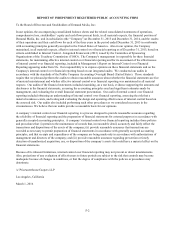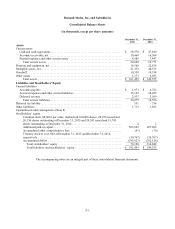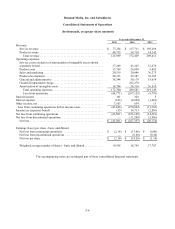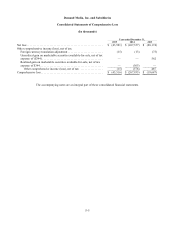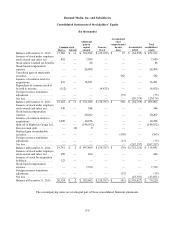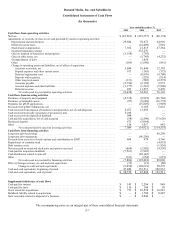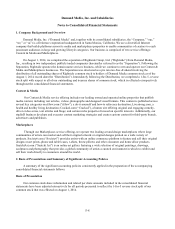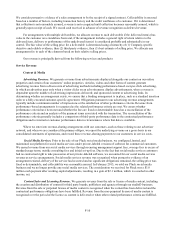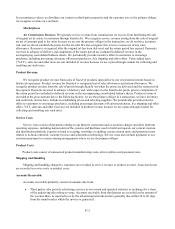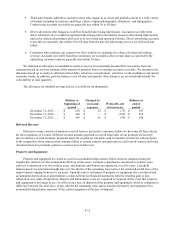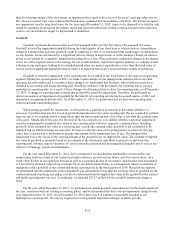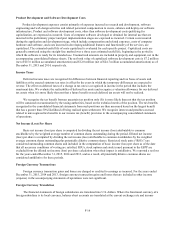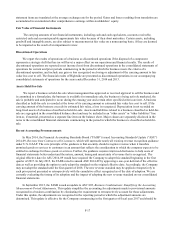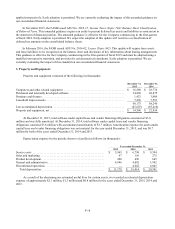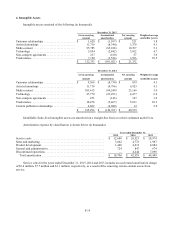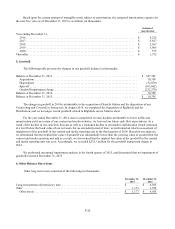Enom 2015 Annual Report Download - page 74
Download and view the complete annual report
Please find page 74 of the 2015 Enom annual report below. You can navigate through the pages in the report by either clicking on the pages listed below, or by using the keyword search tool below to find specific information within the annual report.F-10
We consider persuasive evidence of a sales arrangement to be the receipt of a signed contract. Collectability is assessed
based on a number of factors, including transaction history and the credit worthiness of a customer. If it is determined
that collection is not reasonably assured, revenue is not recognized until collection becomes reasonably assured, which is
generally upon receipt of cash. We record cash received in advance of revenue recognition as deferred revenue.
For arrangements with multiple deliverables, we allocate revenue to each deliverable if the delivered item(s) has
value to the customer on a standalone basis and, if the arrangement includes a general right of return relative to the
delivered item, delivery or performance of the undelivered item(s) is considered probable and substantially in our
control. The fair value of the selling price for a deliverable is determined using a hierarchy of (1) Company-specific
objective and reliable evidence, then (2) third-party evidence, then (3) best estimate of selling price. We allocate any
arrangement fee to each of the elements based on their relative selling prices.
Our revenue is principally derived from the following services and products:
Service Revenue
Content & Media
Advertising Revenue. We generate revenue from advertisements displayed alongside our content on our online
properties and certain of our customers’ online properties. Articles, videos and other forms of content generate
advertising revenue from a diverse mix of advertising methods including performance-based cost-per-click advertising,
in which an advertiser pays only when a visitor clicks on an advertisement; display advertisements, where revenue is
dependent upon the number of advertising impressions delivered; and sponsored content or advertising links. In
determining whether an arrangement exists, we ensure that a binding arrangement is in place, such as a standard insertion
order or a fully executed customer-specific agreement. Obligations pursuant to our advertising revenue arrangements
typically include a minimum number of impressions or the satisfaction of other performance criteria. Revenue from
performance-based arrangements is recognized as the related performance criteria are met. We assess whether
performance criteria have been met and whether the fees are fixed or determinable based on a reconciliation of the
performance criteria and an analysis of the payment terms associated with the transaction. The reconciliation of the
performance criteria generally includes a comparison of third-party performance data to the contractual performance
obligation and to internal or customer performance data in circumstances where that data is available.
Where we enter into revenue-sharing arrangements with our customers, such as those relating to our advertiser
network, and when we are considered the primary obligor, we report the underlying revenue on a gross basis in our
consolidated statements of operations, and record these revenue-sharing payments to our customers in service costs.
Social Media Services. Prior to the sale of our Pluck social media business, we configured, hosted, and
maintained our platform for social media services under private-labeled versions of software for commercial customers.
We earned revenue from our social media services through recurring management support fees, overage fees in excess of
standard usage terms, outside consulting fees and initial set-up fees. Due to the fact that social media services customers
had no contractual right to take possession of our private-labeled software, we accounted for our social media services
revenue as service arrangements. Social media services revenue was recognized when persuasive evidence of an
arrangement existed, delivery of the service had occurred and no significant obligations remained, the selling price was
fixed or determinable, and collectability was reasonably assured. In February 2015, we sold our Pluck social media
business and we no longer provide any social media services. The consideration we received for Pluck was a $3.8
million cash payment after working capital adjustments, resulting in a gain of $2.1 million, which is recorded in other
income, net.
Content Sales and Licensing Revenue. We generate revenue from the sale or license of media content, including
the creation and distribution of content for third party brands, publishers and agencies through our studioD business.
Revenue from the sale or perpetual license of media content is recognized when the content has been delivered and the
contractual performance obligations have been fulfilled. Revenue from the non-perpetual license of media content is
recognized over the period of the license as content is delivered or when other related performance criteria are fulfilled.




